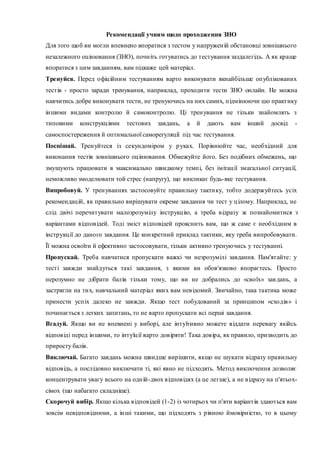―è–Κ –≥–Ψ―²―É–≤–Α―²–Η―¹―è –¥–Ψ –Ζ–Ϋ–Ψ –Ω–Ψ―Ä–Α–¥–Η
- 1. –†–Β–Κ–Ψ–Φ–Β–Ϋ–¥–Α―Ü―•―½ ―É―΅–Ϋ―è–Φ ―â–Ψ–¥–Ψ –Ω―Ä–Ψ―Ö–Ψ–¥–Ε–Β–Ϋ–Ϋ―è –½–ù–û –î–Μ―è ―²–Ψ–≥–Ψ ―â–Ψ–± –≤–Η –Φ–Ψ–≥–Μ–Η –≤–Ω–Β–≤–Ϋ–Β–Ϋ–Ψ –≤–Ω–Ψ―Ä–Α―²–Η―¹―è –Ζ ―²–Β―¹―²–Ψ–Φ ―É –Ϋ–Α–Ω―Ä―É–Ε–Β–Ϋ―•–Ι –Ψ–±―¹―²–Α–Ϋ–Ψ–≤―Ü―• –Ζ–Ψ–≤–Ϋ―•―à–Ϋ―¨–Ψ–≥–Ψ –Ϋ–Β–Ζ–Α–Μ–Β–Ε–Ϋ–Ψ–≥–Ψ –Ψ―Ü―•–Ϋ―é–≤–Α–Ϋ–Ϋ―è (–½–ù–û), –Ω–Ψ―΅–Ϋ―•―²―¨ –≥–Ψ―²―É–≤–Α―²–Η―¹―¨ –¥–Ψ ―²–Β―¹―²―É–≤–Α–Ϋ–Ϋ―è –Ζ–Α–Ζ–¥–Α–Μ–Β–≥―•–¥―¨. –ê ―è–Κ –Κ―Ä–Α―â–Β –≤–Ω–Ψ―Ä–Α―²–Η―¹―è –Ζ ―Ü–Η–Φ –Ζ–Α–≤–¥–Α–Ϋ–Ϋ―è–Φ, –≤–Α–Φ –Ω―•–¥–Κ–Α–Ε–Β ―Ü–Β–Ι –Φ–Α―²–Β―Ä―•–Α–Μ. –Δ―Ä–Β–Ϋ―É–Ι―¹―è. –ü–Β―Ä–Β–¥ –Ψ―³―•―Ü―•–Ι–Ϋ–Η–Φ ―²–Β―¹―²―É–≤–Α–Ϋ–Ϋ―è–Φ –≤–Α―Ä―²–Ψ –≤–Η–Κ–Ψ–Ϋ―É–≤–Α―²–Η ―è–Κ–Ϋ–Α–Ι–±―•–Μ―¨―à–Β –Ψ–Ω―É–±–Μ―•–Κ–Ψ–≤–Α–Ϋ–Η―Ö ―²–Β―¹―²―•–≤ - –Ω―Ä–Ψ―¹―²–Ψ –Ζ–Α―Ä–Α–¥–Η ―²―Ä–Β–Ϋ―É–≤–Α–Ϋ–Ϋ―è, –Ϋ–Α–Ω―Ä–Η–Κ–Μ–Α–¥, –Ω―Ä–Ψ―Ö–Ψ–¥–Η―²–Η ―²–Β―¹―²–Η –½–ù–û –Ψ–Ϋ–Μ–Α–Ι–Ϋ. –ù–Β –Φ–Ψ–Ε–Ϋ–Α –Ϋ–Α–≤―΅–Η―²–Η―¹―¨ –¥–Ψ–±―Ä–Β –≤–Η–Κ–Ψ–Ϋ―É–≤–Α―²–Η ―²–Β―¹―²–Η, –Ϋ–Β ―²―Ä–Β–Ϋ―É―é―΅–Η―¹―¨ –Ϋ–Α –Ϋ–Η―Ö ―¹–Α–Φ–Η―Ö, –Ω―•–¥–Φ―•–Ϋ―é―é―΅–Η ―Ü―é –Ω―Ä–Α–Κ―²–Η–Κ―É ―•–Ϋ―à–Η–Φ–Η –≤–Η–¥–Α–Φ–Η –Κ–Ψ–Ϋ―²―Ä–Ψ–Μ―é –Ι ―¹–Α–Φ–Ψ–Κ–Ψ–Ϋ―²―Ä–Ψ–Μ―é. –Π―• ―²―Ä–Β–Ϋ―É–≤–Α–Ϋ–Ϋ―è –Ϋ–Β ―²―•–Μ―¨–Κ–Η –Ζ–Ϋ–Α–Ι–Ψ–Φ–Μ―è―²―¨ –Ζ ―²–Η–Ω–Ψ–≤–Η–Φ–Η –Κ–Ψ–Ϋ―¹―²―Ä―É–Κ―Ü―•―è–Φ–Η ―²–Β―¹―²–Ψ–≤–Η―Ö –Ζ–Α–≤–¥–Α–Ϋ―¨, –Α –Ι –¥–Α―é―²―¨ –≤–Α–Φ ―•–Ϋ―à–Η–Ι –¥–Ψ―¹–≤―•–¥ - ―¹–Α–Φ–Ψ―¹–Ω–Ψ―¹―²–Β―Ä–Β–Ε–Β–Ϋ–Ϋ―è –Ι –Ψ–Ω―²–Η–Φ–Α–Μ―¨–Ϋ–Ψ―½ ―¹–Α–Φ–Ψ―Ä–Β–≥―É–Μ―è―Ü―•―½ –Ω―•–¥ ―΅–Α―¹ ―²–Β―¹―²―É–≤–Α–Ϋ–Ϋ―è. –ü–Ψ―¹–Ω―•―à–Α–Ι. –Δ―Ä–Β–Ϋ―É–Ι―²–Β―¹―è ―•–Ζ ―¹–Β–Κ―É–Ϋ–¥–Ψ–Φ―•―Ä–Ψ–Φ ―É ―Ä―É–Κ–Α―Ö. –ü–Ψ―Ä―•–≤–Ϋ―é–Ι―²–Β ―΅–Α―¹, –Ϋ–Β–Ψ–±―Ö―•–¥–Ϋ–Η–Ι –¥–Μ―è –≤–Η–Κ–Ψ–Ϋ–Α–Ϋ–Ϋ―è ―²–Β―¹―²―•–≤ –Ζ–Ψ–≤–Ϋ―•―à–Ϋ―¨–Ψ–≥–Ψ –Ψ―Ü―•–Ϋ―é–≤–Α–Ϋ–Ϋ―è. –û–±–Φ–Β–Ε―É–Ι―²–Β –Ι–Ψ–≥–Ψ. –ë–Β–Ζ –Ω–Ψ–¥―•–±–Ϋ–Η―Ö –Ψ–±–Φ–Β–Ε–Β–Ϋ―¨, ―â–Ψ –Ζ–Φ―É―à―É―é―²―¨ –Ω―Ä–Α―Ü―é–≤–Α―²–Η –≤ –Φ–Α–Κ―¹–Η–Φ–Α–Μ―¨–Ϋ–Ψ ―à–≤–Η–¥–Κ–Ψ–Φ―É ―²–Β–Φ–Ω―•, –±–Β–Ζ ―•–Φ―•―²–Α―Ü―•―½ –Ζ–Φ–Α–≥–Α–Μ―¨–Ϋ–Ψ―½ ―¹–Η―²―É–Α―Ü―•―½, –Ϋ–Β–Φ–Ψ–Ε–Μ–Η–≤–Ψ –Ζ–Φ–Ψ–¥–Β–Μ―é–≤–Α―²–Η ―²–Ψ–Ι ―¹―²―Ä–Β―¹ (–Ϋ–Α–Ω―Ä―É–≥―É), ―â–Ψ –≤–Η–Κ–Μ–Η–Κ–Α―î –±―É–¥―¨-―è–Κ–Β ―²–Β―¹―²―É–≤–Α–Ϋ–Ϋ―è. –£–Η–Ω―Ä–Ψ–±–Ψ–≤―É–Ι. –Θ ―²―Ä–Β–Ϋ―É–≤–Α–Ϋ–Ϋ―è―Ö –Ζ–Α―¹―²–Ψ―¹–Ψ–≤―É–Ι―²–Β –Ω―Ä–Α–≤–Η–Μ―¨–Ϋ―É ―²–Α–Κ―²–Η–Κ―É, ―²–Ψ–±―²–Ψ –¥–Ψ–¥–Β―Ä–Ε―É–Ι―²–Β―¹―¨ ―É―¹―•―Ö ―Ä–Β–Κ–Ψ–Φ–Β–Ϋ–¥–Α―Ü―•–Ι, ―è–Κ –Ω―Ä–Α–≤–Η–Μ―¨–Ϋ–Ψ –≤–Η―Ä―•―à―É–≤–Α―²–Η –Ψ–Κ―Ä–Β–Φ–Β –Ζ–Α–≤–¥–Α–Ϋ–Ϋ―è ―΅–Η ―²–Β―¹―² ―É ―Ü―•–Μ–Ψ–Φ―É. –ù–Α–Ω―Ä–Η–Κ–Μ–Α–¥, –Ϋ–Β ―¹–Μ―•–¥ –¥–≤―•―΅―• –Ω–Β―Ä–Β―΅–Η―²―É–≤–Α―²–Η –Φ–Α–Μ–Ψ–Ζ―Ä–Ψ–Ζ―É–Φ―•–Μ―É ―•–Ϋ―¹―²―Ä―É–Κ―Ü―•―é, –Α ―²―Ä–Β–±–Α –≤―•–¥―Ä–Α–Ζ―É –Ε –Ω–Ψ–Ζ–Ϋ–Α–Ι–Ψ–Φ–Η―²–Η―¹―è –Ζ –≤–Α―Ä―•–Α–Ϋ―²–Α–Φ–Η –≤―•–¥–Ω–Ψ–≤―•–¥–Β–Ι. –Δ–Ψ–¥―• –Ζ–Φ―•―¹―² –≤―•–¥–Ω–Ψ–≤―•–¥–Β–Ι –Ω―Ä–Ψ―è―¹–Ϋ–Η―²―¨ –≤–Α–Φ, ―â–Ψ –Ε ―¹–Α–Φ–Β ―î –Ϋ–Β–Ψ–±―Ö―•–¥–Ϋ–Η–Φ –≤ ―•–Ϋ―¹―²―Ä―É–Κ―Ü―•―½ –¥–Ψ –¥–Α–Ϋ–Ψ–≥–Ψ –Ζ–Α–≤–¥–Α–Ϋ–Ϋ―è. –Π–Β –Κ–Ψ–Ϋ–Κ―Ä–Β―²–Ϋ–Η–Ι –Ω―Ä–Η–Κ–Μ–Α–¥ ―²–Α–Κ―²–Η–Κ–Η, ―è–Κ―É ―²―Ä–Β–±–Α –≤–Η–Ω―Ä–Ψ–±–Ψ–≤―É–≤–Α―²–Η. –΅―½ –Φ–Ψ–Ε–Ϋ–Α –Ψ―¹–≤–Ψ―½―²–Η –Ι –Β―³–Β–Κ―²–Η–≤–Ϋ–Ψ –Ζ–Α―¹―²–Ψ―¹–Ψ–≤―É–≤–Α―²–Η, ―²―•–Μ―¨–Κ–Η –Α–Κ―²–Η–≤–Ϋ–Ψ ―²―Ä–Β–Ϋ―É―é―΅–Η―¹―¨ ―É ―²–Β―¹―²―É–≤–Α–Ϋ–Ϋ―•. –ü―Ä–Ψ–Ω―É―¹–Κ–Α–Ι. –Δ―Ä–Β–±–Α –Ϋ–Α–≤―΅–Α―²–Η―¹―è –Ω―Ä–Ψ–Ω―É―¹–Κ–Α―²–Η –≤–Α–Ε–Κ―• ―΅–Η –Ϋ–Β–Ζ―Ä–Ψ–Ζ―É–Φ―•–Μ―• –Ζ–Α–≤–¥–Α–Ϋ–Ϋ―è. –ü–Α–Φ'―è―²–Α–Ι―²–Β: ―É ―²–Β―¹―²―• –Ζ–Α–≤–Ε–¥–Η –Ζ–Ϋ–Α–Ι–¥―É―²―¨―¹―è ―²–Α–Κ―• –Ζ–Α–≤–¥–Α–Ϋ–Ϋ―è, –Ζ ―è–Κ–Η–Φ–Η –≤–Η –Ψ–±–Ψ–≤'―è–Ζ–Κ–Ψ–≤–Ψ –≤–Ω–Ψ―Ä–Α―î―²–Β―¹―¨. –ü―Ä–Ψ―¹―²–Ψ –Ϋ–Β―Ä–Ψ–Ζ―É–Φ–Ϋ–Ψ –Ϋ–Β –¥―•–±―Ä–Α―²–Η –±–Α–Μ―•–≤ ―²―•–Μ―¨–Κ–Η ―²–Ψ–Φ―É, ―â–Ψ –≤–Η –Ϋ–Β –¥–Ψ–±―Ä–Α–Μ–Η―¹―¨ –¥–Ψ ¬Ϊ―¹–≤–Ψ―½―Ö¬Μ –Ζ–Α–≤–¥–Α–Ϋ―¨, –Α –Ζ–Α―¹―²―Ä―è–≥–Μ–Η –Ϋ–Α ―²–Η―Ö, –Ϋ–Α–≤―΅–Α–Μ―¨–Ϋ–Η–Ι –Φ–Α―²–Β―Ä―•–Α–Μ ―è–Κ–Η―Ö –≤–Α–Φ –Ϋ–Β–≤―•–¥–Ψ–Φ–Η–Ι. –½–≤–Η―΅–Α–Ι–Ϋ–Ψ, ―²–Α–Κ–Α ―²–Α–Κ―²–Η–Κ–Α –Φ–Ψ–Ε–Β –Ω―Ä–Η–Ϋ–Β―¹―²–Η ―É―¹–Ω―•―Ö –¥–Α–Μ–Β–Κ–Ψ –Ϋ–Β –Ζ–Α–≤–Ε–¥–Η. –·–Κ―â–Ψ ―²–Β―¹―² –Ω–Ψ–±―É–¥–Ψ–≤–Α–Ϋ–Η–Ι –Ζ–Α –Ω―Ä–Η–Ϋ―Ü–Η–Ω–Ψ–Φ ¬Ϊ―¹―Ö–Ψ–¥―•–≤¬Μ ―• –Ω–Ψ―΅–Η–Ϋ–Α―î―²―¨―¹―è –Ζ –Μ–Β–≥–Κ–Η―Ö –Ζ–Α–Ω–Η―²–Α–Ϋ―¨, ―²–Ψ –Ϋ–Β –≤–Α―Ä―²–Ψ –Ω―Ä–Ψ–Ω―É―¹–Κ–Α―²–Η –≤―¹―• –Ω–Β―Ä―à―• –Ζ–Α–≤–¥–Α–Ϋ–Ϋ―è. –£–≥–Α–¥―É–Ι. –·–Κ―â–Ψ –≤–Η –Ϋ–Β –≤–Ω–Β–≤–Ϋ–Β–Ϋ―• ―É –≤–Η–±–Ψ―Ä―•, –Α–Μ–Β ―•–Ϋ―²―É―½―²–Η–≤–Ϋ–Ψ –Φ–Ψ–Ε–Β―²–Β –≤―•–¥–¥–Α―²–Η –Ω–Β―Ä–Β–≤–Α–≥―É ―è–Κ―•–Ι―¹―¨ –≤―•–¥–Ω–Ψ–≤―•–¥―• –Ω–Β―Ä–Β–¥ ―•–Ϋ―à–Η–Φ–Η, ―²–Ψ ―•–Ϋ―²―É―½―Ü―•―½ –≤–Α―Ä―²–Ψ –¥–Ψ–≤―•―Ä―è―²–Η! –Δ–Α–Κ–Α –¥–Ψ–≤―•―Ä–Α, ―è–Κ –Ω―Ä–Α–≤–Η–Μ–Ψ, –Ω―Ä–Η–Ζ–≤–Ψ–¥–Η―²―¨ –¥–Ψ –Ω―Ä–Η―Ä–Ψ―¹―²―É –±–Α–Μ―•–≤. –£–Η–Κ–Μ―é―΅–Α–Ι. –ë–Α–≥–Α―²–Ψ –Ζ–Α–≤–¥–Α–Ϋ―¨ –Φ–Ψ–Ε–Ϋ–Α ―à–≤–Η–¥―à–Β –≤–Η―Ä―•―à–Η―²–Η, ―è–Κ―â–Ψ –Ϋ–Β ―à―É–Κ–Α―²–Η –≤―•–¥―Ä–Α–Ζ―É –Ω―Ä–Α–≤–Η–Μ―¨–Ϋ―É –≤―•–¥–Ω–Ψ–≤―•–¥―¨, –Α –Ω–Ψ―¹–Μ―•–¥–Ψ–≤–Ϋ–Ψ –≤–Η–Κ–Μ―é―΅–Α―²–Η ―²―•, ―è–Κ―• ―è–≤–Ϋ–Ψ –Ϋ–Β –Ω―•–¥―Ö–Ψ–¥―è―²―¨. –€–Β―²–Ψ–¥ –≤–Η–Κ–Μ―é―΅–Β–Ϋ–Ϋ―è –¥–Ψ–Ζ–≤–Ψ–Μ―è―î –Κ–Ψ–Ϋ―Ü–Β–Ϋ―²―Ä―É–≤–Α―²–Η ―É–≤–Α–≥―É –≤―¹―¨–Ψ–≥–Ψ –Ϋ–Α –Ψ–¥–Ϋ―•–Ι-–¥–≤–Ψ―Ö –≤―•–¥–Ω–Ψ–≤―•–¥―è―Ö (–Α ―Ü–Β –Μ–Β–≥―à–Β), –Α –Ϋ–Β –≤―•–¥―Ä–Α–Ζ―É –Ϋ–Α –Ω'―è―²―¨–Ψ―Ö- ―¹―•–Φ–Ψ―Ö (―â–Ψ –Ϋ–Α–±–Α–≥–Α―²–Ψ ―¹–Κ–Μ–Α–¥–Ϋ―•―à–Β). –Γ–Κ–Ψ―Ä–Ψ―΅―É–Ι –≤–Η–±―•―Ä. –·–Κ―â–Ψ –Κ―•–Μ―¨–Κ–Α –≤―•–¥–Ω–Ψ–≤―•–¥–Β–Ι (1-2) ―•–Ζ ―΅–Ψ―²–Η―Ä―¨–Ψ―Ö ―΅–Η –Ω'―è―²–Η –≤–Α―Ä―•–Α–Ϋ―²―•–≤ –Ζ–¥–Α―é―²―¨―¹―è –≤–Α–Φ –Ζ–Ψ–≤―¹―•–Φ –Ϋ–Β–≤―•–¥–Ω–Ψ–≤―•–¥–Ϋ–Η–Φ–Η, –Α ―•–Ϋ―à―• ―²–Α–Κ–Η–Φ–Η, ―â–Ψ –Ω―•–¥―Ö–Ψ–¥―è―²―¨ –Ζ ―Ä―•–≤–Ϋ–Ψ―é –Ι–Φ–Ψ–≤―•―Ä–Ϋ―•―¹―²―é, ―²–Ψ –≤ ―Ü―¨–Ψ–Φ―É
- 2. –≤–Η–Ω–Α–¥–Κ―É –Ω―Ä–Α–≤–Η–Μ―¨–Ϋ―•―à–Β –±―É–¥–Β –Ϋ–Β –Ω―Ä–Ψ–Ω―É―¹–Κ–Α―²–Η ―Ü–Β –Ζ–Α–≤–¥–Α–Ϋ–Ϋ―è, –Α –Ϋ–Α–Φ–Α–≥–Α―²–Η―¹―¨ –≤–Η–±―Ä–Α―²–Η –≤―•–¥–Ω–Ψ–≤―•–¥―¨ –Ζ ―•–Ϋ―à–Η―Ö –Ω―Ä–Ψ―¹―²–Ψ –Ϋ–Α–≤–Φ–Α–Ϋ–Ϋ―è. –®–Μ―è―Ö–Ψ–Φ ―²–Α–Κ–Ψ―½ ―²–Α–Κ―²–Η–Κ–Η –≤–Η –Ψ―²―Ä–Η–Φ–Α―î―²–Β –±―•–Μ―¨―à–Β –±–Α–Μ―•–≤. –Π–Β - ―²–Β–Ψ―Ä―•―è –Ι–Φ–Ψ–≤―•―Ä–Ϋ–Ψ―¹―²―•. –ê–¥–Ε–Β ¬Ϊ–Ϋ–Β–≥–Α―²–Η–≤–Ϋ–Β –Ζ–Ϋ–Α–Ϋ–Ϋ―è¬Μ (–Ω―Ä–Ψ ―²–Β, ―è–Κ–Α –≤―•–¥–Ω–Ψ–≤―•–¥―¨ ―²–Ψ―΅–Ϋ–Ψ –Ϋ–Β –Ω―•–¥―Ö–Ψ–¥–Η―²―¨) - ―Ü–Β ―²–Β–Ε –Ζ–Ϋ–Α–Ϋ–Ϋ―è, ―• –Ϋ–Β―Ä–Ψ–Ζ―É–Φ–Ϋ–Ψ –≤―•–¥–Φ–Ψ–≤–Μ―è―²–Η―¹―¨ –≤―•–¥ –Ι–Ψ–≥–Ψ –≤–Η–Κ–Ψ―Ä–Η―¹―²–Α–Ϋ–Ϋ―è. –î―É–Φ–Α–Ι ―²―•–Μ―¨–Κ–Η –Ω―Ä–Ψ –Ω–Ψ―²–Ψ―΅–Ϋ–Β –Ζ–Α–≤–¥–Α–Ϋ–Ϋ―è. –ö–Ψ–Μ–Η –≤–Η –±–Α―΅–Η―²–Β –Ζ–Α–≤–¥–Α–Ϋ–Ϋ―è (–Ζ–Α–Ω–Η―²–Α–Ϋ–Ϋ―è), –Ζ–Α–±―É–≤–Α–Ι―²–Β –≤―¹–Β, ―â–Ψ –±―É–Μ–Ψ –≤ –Ω–Ψ–Ω–Β―Ä–Β–¥–Ϋ―¨–Ψ–Φ―É: ―è–Κ –Ω―Ä–Α–≤–Η–Μ–Ψ, –Ζ–Α–≤–¥–Α–Ϋ–Ϋ―è –≤ ―²–Β―¹―²–Α―Ö –Ϋ–Β –Ω–Ψ–≤'―è–Ζ–Α–Ϋ―• –Ψ–¥–Ϋ–Β –Ζ –Ψ–¥–Ϋ–Η–Φ, ―²–Ψ–Φ―É –Ζ–Ϋ–Α–Ϋ–Ϋ―è, ―è–Κ―• –≤–Η –Ζ–Α―¹―²–Ψ―¹―É–≤–Α–Μ–Η –≤ –Ψ–¥–Ϋ–Ψ–Φ―É (―É–Ε–Β –≤–Η―Ä―•―à–Β–Ϋ–Ψ–Φ―É –≤–Α–Φ–Η), ―è–Κ –Ω―Ä–Α–≤–Η–Μ–Ψ, –Ϋ–Β –¥–Ψ–Ω–Ψ–Φ–Α–≥–Α―é―²―¨, –Α ―²―•–Μ―¨–Κ–Η –Ζ–Α–≤–Α–Ε–Α―é―²―¨ ―¹–Κ–Ψ–Ϋ―Ü–Β–Ϋ―²―Ä―É–≤–Α―²–Η―¹―¨ ―• –Ω―Ä–Α–≤–Η–Μ―¨–Ϋ–Ψ –≤–Η―Ä―•―à–Η―²–Η ―•–Ϋ―à–Β –Ζ–Α–≤–¥–Α–Ϋ–Ϋ―è. –Π―è ―É―¹―²–Α–Ϋ–Ψ–≤–Κ–Α –¥–Α―î –±–Β–Ζ―Ü―•–Ϋ–Ϋ–Η–Ι –Ω―¹–Η―Ö–Ψ–Μ–Ψ–≥―•―΅–Ϋ–Η–Ι –Β―³–Β–Κ―² - –Ζ–Α–±―É–¥―¨―²–Β –Ω―Ä–Ψ –Ϋ–Β–≤–¥–Α―΅―É –≤ –Φ–Η–Ϋ―É–Μ–Ψ–Φ―É –Ζ–Α–≤–¥–Α–Ϋ–Ϋ―• (―è–Κ―â–Ψ –≤–Ψ–Ϋ–Ψ –≤–Η―è–≤–Η–Μ–Ψ―¹―¨ –≤–Α–Φ ¬Ϊ–Ϋ–Β –Ω–Ψ –Ζ―É–±–Α―Ö¬Μ). –î―É–Φ–Α–Ι―²–Β ―²―•–Μ―¨–Κ–Η –Ω―Ä–Ψ ―²–Β, ―â–Ψ –Κ–Ψ–Ε–Ϋ–Β –Ϋ–Ψ–≤–Β –Ζ–Α–≤–¥–Α–Ϋ–Ϋ―è - ―Ü–Β ―à–Α–Ϋ―¹ –Ϋ–Α–±―Ä–Α―²–Η –±–Α–Μ–Η. –ß–Η―²–Α–Ι –Ζ–Α–≤–¥–Α–Ϋ–Ϋ―è –¥–Ψ –Κ―•–Ϋ―Ü―è. –ü–Ψ―¹–Ω―•―Ö –Ϋ–Β –Ω–Ψ–≤–Η–Ϋ–Β–Ϋ –Ω―Ä–Η–Ζ–≤–Ψ–¥–Η―²–Η –¥–Ψ ―²–Ψ–≥–Ψ, ―â–Ψ –≤–Η –±―É–¥–Β―²–Β –Ϋ–Α–Φ–Α–≥–Α―²–Η―¹―è –Ζ―Ä–Ψ–Ζ―É–Φ―•―²–Η ―É–Φ–Ψ–≤–Η –Ζ–Α–≤–¥–Α–Ϋ–Ϋ―è –Ζ–Α ¬Ϊ–Ω–Β―Ä―à–Η–Φ–Η ―¹–Μ–Ψ–≤–Α–Φ–Η¬Μ –Ι –¥–Ψ–±―É–¥–Ψ–≤―É–≤–Α―²–Η –Κ―•–Ϋ―Ü―•–≤–Κ―É ―É –≤–Μ–Α―¹–Ϋ―•–Ι ―É―è–≤―•. –Π–Β –≤―•―Ä–Ϋ–Η–Ι ―¹–Ω–Ψ―¹―•–± –Ζ―Ä–Ψ–±–Η―²–Η –Ω―Ä–Η–Κ―Ä―• –Ω–Ψ–Φ–Η–Μ–Κ–Η –≤ –Ϋ–Α–Ι–Μ–Β–≥―à–Η―Ö –Ζ–Α–Ω–Η―²–Α–Ϋ–Ϋ―è―Ö. –ù–Β –Ζ–Α―¹–Φ―É―΅―É–Ι―¹―è. –Θ –±―É–¥―¨-―è–Κ–Ψ–Φ―É –Ω―Ä–Ψ―³–Β―¹―•–Ι–Ϋ–Ψ –Ω―•–¥–≥–Ψ―²–Ψ–≤–Μ–Β–Ϋ–Ψ–Φ―É ―²–Β―¹―²―• ―î –Ζ–Α–≤–¥–Α–Ϋ–Ϋ―è, –Ζ ―è–Κ–Η–Φ–Η –≤–Η –Ω―Ä–Ψ―¹―²–Ψ –Ϋ–Β –Ζ–Φ–Ψ–Ε–Β―²–Β –≤–Ω–Ψ―Ä–Α―²–Η―¹―¨. –ë―•–Μ―¨―à–Β ―²–Ψ–≥–Ψ, ―É―¹―• 100 % –Ζ–Α–≤–¥–Α–Ϋ―¨ –Ζ–Φ–Ψ–Ε―É―²―¨ –≤–Η–Κ–Ψ–Ϋ–Α―²–Η –Μ–Η―à–Β –Ψ–¥–Η–Ϋ–Η―Ü―•! –Δ–Ψ–Φ―É –Ϋ–Β–Φ–Α―î –Ϋ―•―è–Κ–Ψ–≥–Ψ ―¹–Β–Ϋ―¹―É ―Ä–Ψ–Ζ―Ö–Μ―é–Ω―É–≤–Α―²–Η –Β–Φ–Ψ―Ü―•–Ι–Ϋ―É –Β–Ϋ–Β―Ä–≥―•―é –Ϋ–Α –Ω–Β―Ä–Β–¥―΅–Α―¹–Ϋ―É –¥–Ψ―¹–Α–¥―É. –ù–Α–≤―•―²―¨ ―è–Κ―â–Ψ –≤–Α–Φ –Ζ–¥–Α―î―²―¨―¹―è, ―â–Ψ –≤–Η –¥–Ψ–Ω―É―¹―²–Η–Μ–Η –Ζ–Α–Ϋ–Α–¥―²–Ψ –Ω–Ψ–Φ–Η–Μ–Ψ–Κ ―• –Ω―Ä–Ψ―¹―²–Ψ –Ζ–Α–≤–Α–Μ–Η–Μ–Η ―²–Β―¹―², –Ω–Α–Φ'―è―²–Α–Ι―²–Β, ―â–Ψ –¥―É–Ε–Β ―΅–Α―¹―²–Ψ ―²–Α–Κ–Β –≤―•–¥―΅―É―²―²―è ―î –Ω–Ψ–Φ–Η–Μ–Κ–Ψ–≤–Η–Φ: –Ω―Ä–Η –Ω–Ψ―Ä―•–≤–Ϋ―è–Ϋ–Ϋ―• –≤–Α―à–Η―Ö ―Ä–Β–Ζ―É–Μ―¨―²–Α―²―•–≤ –Ζ ―•–Ϋ―à–Η–Φ–Η –Φ–Ψ–Ε–Β –Ζ'―è―¹―É–≤–Α―²–Η―¹―è, ―â–Ψ ―•–Ϋ―à―• –¥–Ψ–Ω―É―¹―²–Η–Μ–Η ―â–Β –±―•–Μ―¨―à–Β –Ω–Ψ–Φ–Η–Μ–Ψ–Κ. –Θ –Ω―•–¥―¹―É–Φ–Κ―É –≤–Η –Ψ–¥–Β―Ä–Ε–Η―²–Β ―è–Κ―â–Ψ –Ϋ–Β –Ϋ–Α–Ι–≤–Η―â–Η–Ι ―²–Β―¹―²–Ψ–≤–Η–Ι –±–Α–Μ, ―²–Ψ ―Ü―•–Μ–Κ–Ψ–Φ –Ω―Ä–Η―¹―²–Ψ–Ι–Ϋ–Η–Ι. –Π―è ―É―¹―²–Α–Ϋ–Ψ–≤–Κ–Α –Ψ―¹–Ψ–±–Μ–Η–≤–Ψ –Ζ–Ϋ–Α–¥–Ψ–±–Η―²―¨―¹―è ¬Ϊ–Κ―Ä―É–≥–Μ–Η–Φ –≤―•–¥–Φ―•–Ϋ–Ϋ–Η–Κ–Α–Φ¬Μ, ―è–Κ―• –Ζ–≤–Η–Κ–Μ–Η –Ω―Ä–Η –Ζ–≤–Η―΅–Α–Ι–Ϋ–Η―Ö –Φ–Β―²–Ψ–¥–Α―Ö –Κ–Ψ–Ϋ―²―Ä–Ψ–Μ―é –¥–Ψ–Φ–Α–≥–Α―²–Η―¹―¨ –Φ–Α–Κ―¹–Η–Φ–Α–Μ―¨–Ϋ–Ψ–≥–Ψ ―Ä–Β–Ζ―É–Μ―¨―²–Α―²―É. –·–Κ―â–Ψ –≤–Η ―Ö–Ψ―΅–Β―²–Β ―¹―²–Α―²–Η –Κ–Μ–Α―¹–Ϋ–Η–Φ ¬Ϊ―²–Β―¹―²–Ψ–≤–Η–Φ –±―•–Ι―Ü–Β–Φ¬Μ, –Ϋ–Α–≤―΅–Α–Ι―²–Β―¹―¨ –Ϋ–Β ―²―•–Μ―¨–Κ–Η –Ϋ–Α–Ϋ–Ψ―¹–Η―²–Η ―É–¥–Α―Ä–Η, –Α –Ι ¬Ϊ―²―Ä–Η–Φ–Α―²–Η¬Μ ―½―Ö (―è–Κ―â–Ψ –≤–Η―¹–Μ–Ψ–≤–Μ―é–≤–Α―²–Η―¹―¨ ―²–Β―Ä–Φ―•–Ϋ–Α–Φ–Η –±–Ψ–Κ―¹―É). –Δ―Ä–Β–±–Α –Κ–Α―²–Β–≥–Ψ―Ä–Η―΅–Ϋ–Ψ –≤―•–¥–Φ–Ψ–≤–Η―²–Η―¹―¨ –≤―•–¥ ¬Ϊ–Κ–Ψ–Φ–Ω–Μ–Β–Κ―¹―É –≤―•–¥–Φ―•–Ϋ–Ϋ–Η–Κ–Α¬Μ, ―è–Κ–Η–Ι –Ϋ–Β –Ζ–≤–Η–Κ –Ϋ–Β–Ω–Ψ―Ö–Η―²–Ϋ–Ψ –Ω–Β―Ä–Β–Ϋ–Ψ―¹–Η―²–Η –Ψ–Κ―Ä–Β–Φ―• –Μ–Ψ–Κ–Α–Μ―¨–Ϋ―• –Ϋ–Β–≤–¥–Α―΅―•. –½–Α–Ω–Μ–Α–Ϋ―É–Ι –¥–≤–Α –Κ–Ψ–Μ–Α. –Γ–Ω–Μ–Α–Ϋ―É–Ι―²–Β ―¹–Β―Ä–Β–¥–Ϋ―•–Ι ―΅–Α―¹ –Ϋ–Α –Κ–Ψ–Ε–Ϋ–Β –Ζ–Α–≤–¥–Α–Ϋ–Ϋ―è ―²–Α–Κ–Η–Φ ―΅–Η–Ϋ–Ψ–Φ, ―â–Ψ–± –Ζ–Α –¥–≤―• ―²―Ä–Β―²–Η–Ϋ–Η (–Φ–Α–Κ―¹–Η–Φ―É–Φ ―²―Ä–Η ―΅–≤–Β―Ä―²―•) ―²–Β―¹―²―É–≤–Α–Ϋ–Ϋ―è –Ω―Ä–Ψ–Ι―²–Η –≤―¹―• –Ζ–Α–≤–¥–Α–Ϋ–Ϋ―è ¬Ϊ–Ζ–Α –Ω–Β―Ä―à–Η–Φ –Κ–Ψ–Μ–Ψ–Φ¬Μ. –Δ–Ψ–¥―• –≤–Η –≤―¹―²–Η–≥–Ϋ–Β―²–Β –Ϋ–Α–±―Ä–Α―²–Η –Φ–Α–Κ―¹–Η–Φ―É–Φ –±–Α–Μ―•–≤ –Ϋ–Α –Μ–Β–≥–Κ–Η―Ö –¥–Μ―è –≤–Α―¹ (¬Ϊ―¹–≤–Ψ―½―Ö¬Μ) –Ζ–Α–≤–¥–Α–Ϋ–Ϋ―è―Ö, –Α –Ω–Ψ―²―•–Φ –Ζ–Φ–Ψ–Ε–Β―²–Β –Ω–Ψ–¥―É–Φ–Α―²–Η –Ι –¥–Ψ–±―Ä–Α―²–Η ―â–Ψ―¹―¨ –Ϋ–Α –≤–Α–Ε–Κ–Η―Ö, ―è–Κ―• –≤–Α–Φ ―¹–Ω–Ψ―΅–Α―²–Κ―É –¥–Ψ–≤–Β–Μ–Ψ―¹―¨ –Ω―Ä–Ψ–Ω―É―¹―²–Η―²–Η.





































































